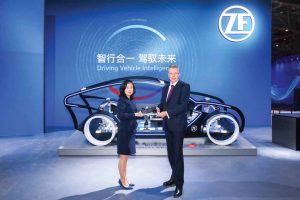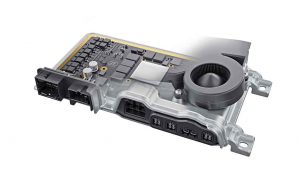The ZF ProAI, a next-generation automotive-grade supercomputer is aimed at meeting the manufacturer needs for software-defined vehicles and their new E/E architectures. Team ACI looks at the new and exciting offering from the ZF Group.
Software functions in vehicles are growing by the day. Add to it its combined strength with the intelligence of sensor information is known to give rise to the driver-assist functions. These driver functions are the hotbed for comfort, added safety and perhaps extended range when driving electrically. Coming off age, in comparison to the traditional vehicle architectures, wherein the exchange is mainly in the decentralised Electronic Control Units (ECUs). It lays the foundation for a dramatic change in Electric and Electronic (E/E) architecture. The future entails the bundling of the computing power and the main software functions in a few domain or zone controllers. The ProAI, displayed at Auto Shanghai 2021, for the first time, is claimed to meet the manufacturers’ requirements for software-defined vehicles and their new E/E-architectures. Stated Oliver Briemle, Head of L4 Feature Development, Domain Control and V2X at ZF, “The ZF ProAI is currently the most flexible, scalable, and powerful automotive-grade supercomputer in the world.” Briemle deemed it suitable for any vehicle type and all levels of automated and autonomous driving: from Level 2 to Level 5.
ZF ProAI
The ZF ProAI automotive-grade supercomputer represents customised high-performance solutions for vehicle intelligence. It is platform agnostic yet based on a single product. As per Briemle, at the time of developing the ZF ProAI, the company paid particular attention to two things: standardisation and scalability. Explaining the two prime considerations as key for the processor and the connectors, he explained, the supercomputer’s modular set-up means it the be equipped with System-on-Chip (SoC) variants from different manufacturers – depending on the planned application and the computing power required. Additionally, the connectors are claimed to be compatible with all common plugs on the market. The attention was also on relying on the highest level of flexibility regarding software.
In addition to in-house solutions, the supercomputer also runs programs and operating systems of the OEMs or third-party developers. Depending on the desired performance, three cooling options are available: passive cooling, air cooling and liquid cooling. Irrespective of the option chosen, the installation dimensions will remain the same.
The ZF ProAI The ZF ProAI features a uniform and compact housing size of 240 mm x 138 mm x 49 mm. It is claimed to be significantly smaller than the previous generations. With improved performance, for instance, in any desired application from Level 2 to Level 5, it can meet the corresponding computing power required. The supercomputer is capable of executing between 20 trillion and one quadrillion computing steps per second. With a performance of up to 250 TOPS per unit, an increase of 66 per cent compared to the previous model, the ZF ProAI RoboThink.
Over the previous generation, power consumption is claimed to drop to a greater extent. With one watt of power, the ProAI achieves a performance of approximately three TOPS. It translates to up to 70 per cent less power consumption. The automotive-grade product in its built is claimed to be more high-tech and built with a higher reliance keeping in mind the harsh operational conditions. The ZF ProAI also offers an ASIL-D computing performance with state-of-the-art protection against cyber threats.
The AI capabilities of ZF ProAI have been optimised for deep learning processes and claimed to further enhance its ability to deliver advanced safety features. The board offers a 360-degree GPU-driven fusion of all available sensor data, including environmental measurement data from radars, LiDARs, cameras and audio patterns. In addition to it, ZF has provided a Measurement Data Interface (MDI) for the ProAI to forward the collected sensor data, unaltered, to a central storage system for development and testing purposes. It is for the ease of developers to train artificial intelligence for autonomous driving. The company claims to have gained traction with the first volume production for the latest version of the ZF ProAI expected to start in 2024. ACI













Leave a Reply